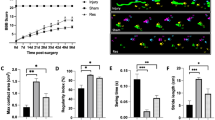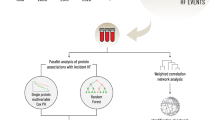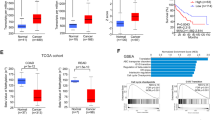Abstract
Loss-of-function mutations in filamin A (FLNA) cause an X-linked dominant disorder with multiple organ involvement. Affected females present with periventricular nodular heterotopia (PVNH), cardiovascular complications, thrombocytopenia and Ehlers–Danlos syndrome. These mutations are typically lethal to males, and rare male survivors suffer from failure to thrive, PVNH, and severe cardiovascular and gastrointestinal complications. Here we report two surviving male siblings with a loss-of-function mutation in FLNA. They presented with multiple complications, including valvulopathy, intestinal malrotation and chronic intestinal pseudo-obstruction (CIPO). However, these siblings had atypical clinical courses, such as a lack of PVNH and a spontaneous improvement of CIPO. Trio-based whole-exome sequencing revealed a 4-bp deletion in exon 40 that was predicted to cause a lethal premature protein truncation. However, molecular investigations revealed that the mutation induced in-frame skipping of the mutated exon, which led to the translation of a mutant FLNA missing an internal region of 41 amino acids. Functional analyses of the mutant protein suggested that its binding affinity to integrin, as well as its capacity to induce focal adhesions, were comparable to those of the wild-type protein. These results suggested that exon skipping of FLNA partially restored its protein function, which could contribute to amelioration of the siblings’ clinical courses. This study expands the diversity of the phenotypes associated with loss-of-function mutations in FLNA.
Similar content being viewed by others
Log in or create a free account to read this content
Gain free access to this article, as well as selected content from this journal and more on nature.com
or
References
Zhou AX, Hartwig JH, Akyurek LM : Filamins in cell signaling, transcription and organ development. Trends Cell Biol 2010; 20: 113–123.
Nakamura F, Osborn TM, Hartemink CA, Hartwig JH, Stossel TP : Structural basis of filamin A functions. J Cell Biol 2007; 179: 1011–1025.
Ehrlicher AJ, Nakamura F, Hartwig JH, Weitz DA, Stossel TP : Mechanical strain in actin networks regulates FilGAP and integrin binding to filamin A. Nature 2011; 478: 260–263.
Kim H, McCulloch CA : Filamin A mediates interactions between cytoskeletal proteins that control cell adhesion. FEBS Lett 2011; 585: 18–22.
Nakamura F, Stossel TP, Hartwig JH : The filamins: organizers of cell structure and function. Cell Adh Migr 2011; 5: 160–169.
Fox JW, Lamperti ED, Eksioglu YZ et al: Mutations in filamin 1 prevent migration of cerebral cortical neurons in human periventricular heterotopia. Neuron 1998; 21: 1315–1325.
Parrini E, Ramazzotti A, Dobyns WB et al: Periventricular heterotopia: phenotypic heterogeneity and correlation with filamin A mutations. Brain 2006; 129: 1892–1906.
Reinstein E, Frentz S, Morgan T et al: Vascular and connective tissue anomalies associated with X-linked periventricular heterotopia due to mutations in Filamin A. Eur J Hum Genet 2013; 21: 494–502.
Kyndt F, Gueffet JP, Probst V et al: Mutations in the gene encoding filamin A as a cause for familial cardiac valvular dystrophy. Circulation 2007; 115: 40–49.
Nurden P, Debili N, Coupry I et al: Thrombocytopenia resulting from mutations in filamin A can be expressed as an isolated syndrome. Blood 2011; 118: 5928–5937.
Oegema R, Hulst JM, Theuns-Valks SD et al: Novel no-stop FLNA mutation causes multi-organ involvement in males. Am J Med Genet A 2013; 161: 2376–2384.
Gargiulo A, Auricchio R, Barone MV et al: Filamin A is mutated in X-linked chronic idiopathic intestinal pseudo-obstruction with central nervous system involvement. Am J Hum Genet 2007; 80: 751–758.
Kapur RP, Robertson SP, Hannibal MC et al: Diffuse abnormal layering of small intestinal smooth muscle is present in patients with FLNA mutations and x-linked intestinal pseudo-obstruction. Am J Surg Pathol 2010; 34: 1528–1543.
van der Werf CS, Sribudiani Y, Verheij JB et al: Congenital short bowel syndrome as the presenting symptom in male patients with FLNA mutations. Genet Med 2013; 15: 310–313.
Guerrini R, Mei D, Sisodiya S et al: Germline and mosaic mutations of FLN1 in men with periventricular heterotopia. Neurology 2004; 63: 51–56.
Hehr U, Hehr A, Uyanik G, Phelan E, Winkler J, Reardon W : A filamin A splice mutation resulting in a syndrome of facial dysmorphism, periventricular nodular heterotopia, and severe constipation reminiscent of cerebro-fronto-facial syndrome. J Med Genet 2006; 43: 541–544.
Li H, Durbin R : Fast and accurate short read alignment with Burrows-Wheeler transform. Bioinformatics 2009; 25: 1754–1760.
McKenna A, Hanna M, Banks E et al: The Genome Analysis Toolkit: a MapReduce framework for analyzing next-generation DNA sequencing data. Genome Res 2010; 20: 1297–1303.
Murata Y, Yasumi T, Shirakawa R et al: Rapid diagnosis of FHL3 by flow cytometric detection of intraplatelet Munc13-4 protein. Blood 2011; 118: 1225–1230.
Schneider CA, Rasband WS, Eliceiri KW NIH Image to ImageJ: 25 years of image analysis Nat Meth 2012; 9: 671–675.
Frisan T, Levitsky V, Masucci M : Generation of lymphoblastoid cell lines (LCLs). Methods Mol Biol 2001; 174: 125–127.
Kunishima S, Hamaguchi M, Saito H : Differential expression of wild-type and mutant NMMHC-IIA polypeptides in blood cells suggests cell-specific regulation mechanisms in MYH9 disorders. Blood 2008; 111: 3015–3023.
Kunishima S, Kobayashi R, Itoh TJ, Hamaguchi M, Saito H : Mutation of the beta1-tubulin gene associated with congenital macrothrombocytopenia affecting microtubule assembly. Blood 2009; 113: 458–461.
Travis MA, van der Flier A, Kammerer RA, Mould AP, Sonnenberg A, Humphries MJ : Interaction of filamin A with the integrin beta 7 cytoplasmic domain: role of alternative splicing and phosphorylation. FEBS Lett 2004; 569: 185–190.
van der Flier A, Kuikman I, Kramer D et al: Different splice variants of filamin-B affect myogenesis, subcellular distribution, and determine binding to integrin [beta] subunits. J Cell Biol 2002; 156: 361–376.
Lad Y, Kiema T, Jiang P et al: Structure of three tandem filamin domains reveals auto-inhibition of ligand binding. EMBO J 2007; 26: 3993–4004.
Pentikainen U, Jiang P, Takala H, Ruskamo S, Campbell ID, Ylanne J : Assembly of a filamin four-domain fragment and the influence of splicing variant-1 on the structure. J Biol Chem 2011; 286: 26921–26930.
Kiema T, Lad Y, Jiang P et al: The molecular basis of filamin binding to integrins and competition with talin. Mol Cell 2006; 21: 337–347.
Lad Y, Jiang P, Ruskamo S et al: Structural basis of the migfilin-filamin interaction and competition with integrin beta tails. J Biol Chem 2008; 283: 35154–35163.
Sheen VL : Filamin A mediated Big2 dependent endocytosis: from apical abscission to periventricular heterotopia. Tissue barriers 2014; 2: e29431.
Guerrini R, Dobyns WB : Malformations of cortical development: clinical features and genetic causes. Lancet Neurol 2014; 13: 710–726.
Antonucci A, Fronzoni L, Cogliandro L et al: Chronic intestinal pseudo-obstruction. World J Gastroenterol 2008; 14: 2953–2961.
Acknowledgements
We thank the patients and their family members for participating in our study, Ms Yuki Takaoka for her technical assistance and Dr Hisanori Horiuchi for his kind advice on platelet analysis. This work was supported by grants from the Japanese Ministry of Education, Culture, Sports, Science, and Technology, and the Japanese Ministry of Health, Labor, and Welfare.
Author Contributions
HO performed genetic and molecular analyses, and wrote the paper. TS, KN, KI, EH, H Nunoi and SH performed molecular investigations of the FLNA mutation. HS and SK performed imaging analysis of blood cells. H Numabe performed genetic counseling and performed genetic analyses. AH and OO performed whole-exome sequencing. HM and TM performed genetic analysis of Marfan syndrome-related genes and whole-exome sequencing. HD, KK, SO and H Nakase participated in the patients’ diagnosis and contributed to writing the manuscript. TK, TY, RN and TH designed the study and contributed to writing the manuscript.
Author information
Authors and Affiliations
Corresponding author
Ethics declarations
Competing interests
The authors declare no conflict of interest.
Additional information
Supplementary Information accompanies this paper on European Journal of Human Genetics website
Supplementary information
Rights and permissions
About this article
Cite this article
Oda, H., Sato, T., Kunishima, S. et al. Exon skipping causes atypical phenotypes associated with a loss-of-function mutation in FLNA by restoring its protein function. Eur J Hum Genet 24, 408–414 (2016). https://doi.org/10.1038/ejhg.2015.119
Received:
Revised:
Accepted:
Published:
Issue date:
DOI: https://doi.org/10.1038/ejhg.2015.119
This article is cited by
-
Cardiovascular and connective tissue disorder features in FLNA-related PVNH patients: progress towards a refined delineation of this syndrome
Orphanet Journal of Rare Diseases (2021)
-
Prune belly syndrome in surviving males can be caused by Hemizygous missense mutations in the X-linked Filamin A gene
BMC Medical Genetics (2020)
-
Update on a previously reported male with a FLNA missense mutation
European Journal of Human Genetics (2017)
-
Reply to Walsh et al
European Journal of Human Genetics (2017)



